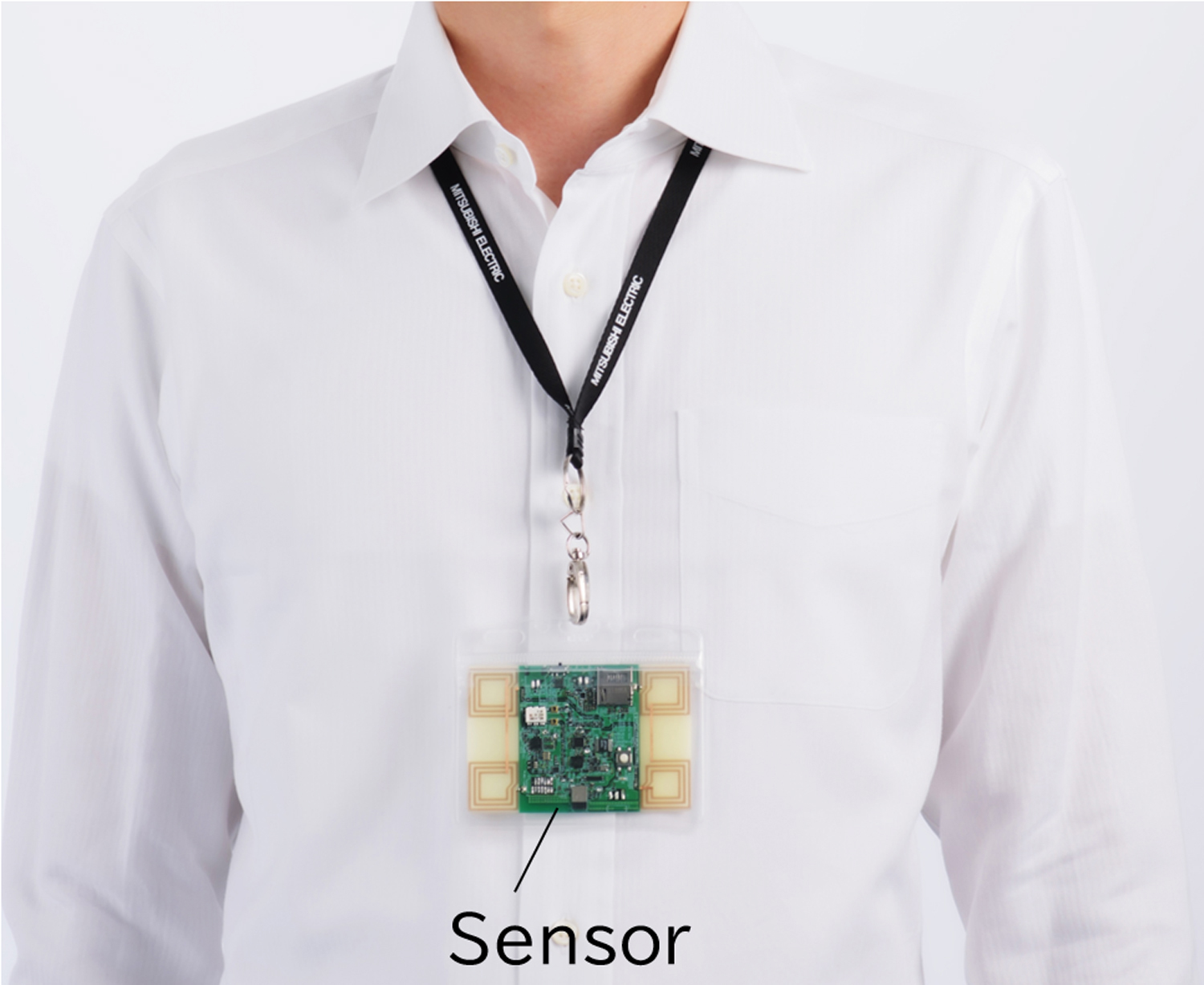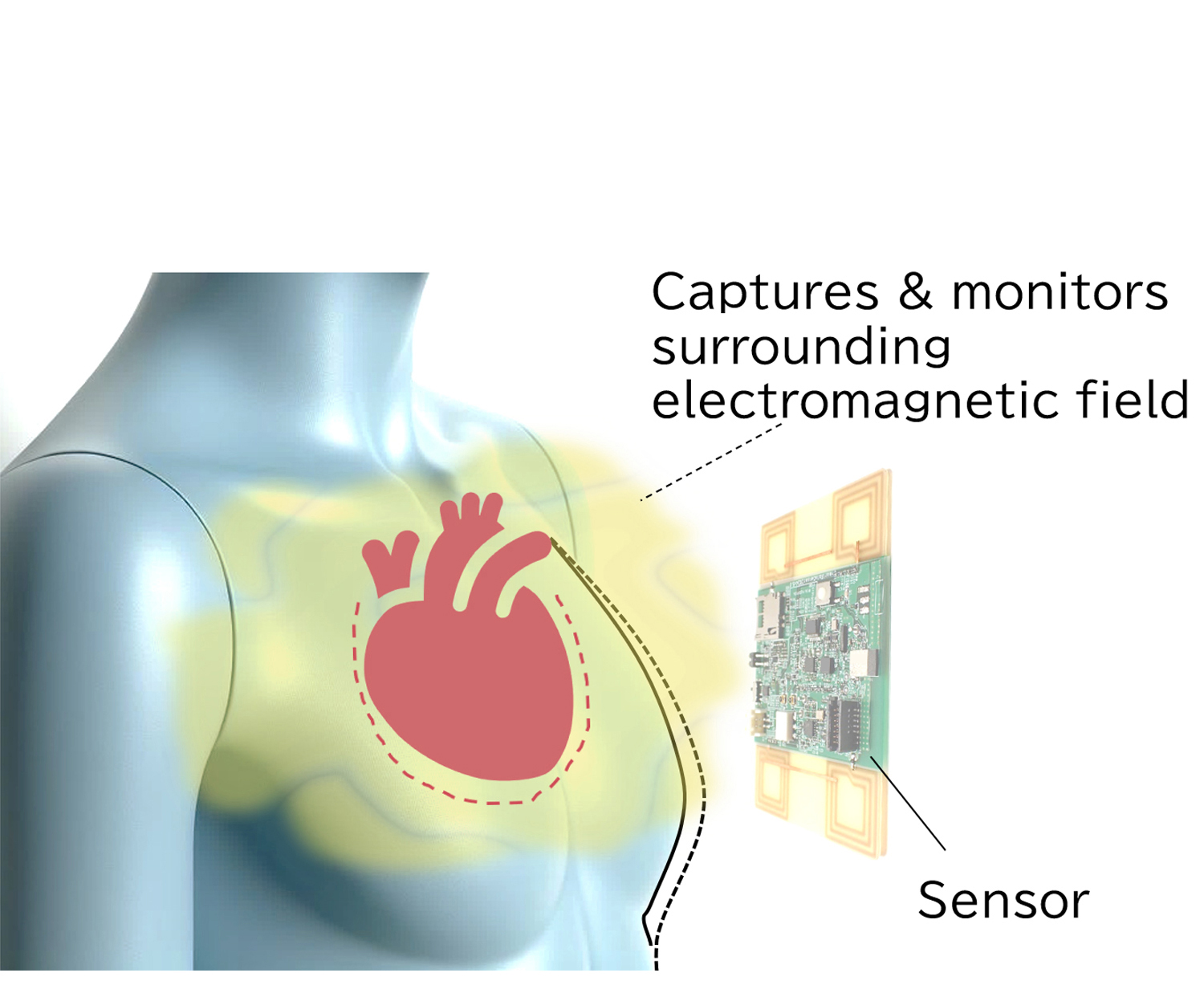News
Mitsubishi Electric Develops New Contactless Body Sensor Allowing High-Precision Monitoring of Vital Body Data

Example Deployment – Embedded in Employee ID Card

Illustration of Sensing Range
TOKYO, September 30, 2025 - Mitsubishi Electric Corporation (TOKYO: 6503) announced today that it has developed a new type of contactless body data sensor that can detect minute variations in heart rates, respiration, and other vital body indicators1 with high precision.2 It will enable the continuous and accurate daily measurement of such data in situations where the use of contact-type sensors, such as smartwatches, may be difficult. The new sensor will help enhance people’s health, security and well-being by facilitating self-management and monitoring of key body indicators, particularly among the elderly.
In recent years, the widespread use of smartwatches and other monitoring devices has led to increasing numbers of people checking their own body data on a daily basis, allowing them to assess their own physical and mental condition for health management purposes. Companies are also increasingly seeing a link between their employees’ health and their productivity levels. There is accordingly growing interest in new solutions that utilize vital body data to allow employees to monitor their physical and mental states, and help companies to provide appropriate working environments for them, as well as identify aspects of these that can be improved.
The effective collection, analysis and utilization of vital body data obtained through daily biosensing is additionally seen as a key means of helping to achieve the Japanese government’s goal of extending healthy life expectancy by more than three years by 2040.3 The effectiveness of wearable contact-type sensors such as smartwatches may be hampered in certain situations due to issues such as wearer discomfort, skin irritation or the need to ensure the safety of the wearer. As a result, there is growing interest in the use of non-contact sensors capable of measuring vital body indicators with a high degree of accuracy.
The new sensor is a unique type of non-contact device capable of measuring heart rate and other vital body signs. It captures minute variations in measurements of the surface of the human body and internal organs, using weak radio waves to detect changes in the surrounding electromagnetic field. The sensor itself detects unique features of the wearer such as their body composition and the position of their sensor, automatically optimizing its sensitivity to ensure stable monitoring at all times. Sensing accuracy is further enhanced by the ability of the device to detect heartbeats transmitted through clothing and to sense changes in the electromagnetic field. This allows for the high-precision measurement of vital data without direct skin contact, even through clothing.
Furthermore, by employing multimodal sensing and leveraging a heartbeat interval extraction algorithm based on machine-learning, the sensor achieves accuracy comparable to contact-type devices such as smartwatches.4 Mitsubishi Electric aims to expand the application of vital sensing technology by enabling users to select the most suitable sensor device from a variety of options according to the usage scenario and their individual condition and preferences.5
Going forward, Mitsubishi Electric will continue its research and development of solutions that enhance workplace productivity by using highly precise vital organ data to analyze employees’ psychological states and allowing companies to use the results to provide more customized work environments. Additionally, by progressing its research into the application of this sensing technology beyond heartbeat interval measurement, the company aims to help boost people’s well-being and peace of mind in the workplace.
- 1
This sensor can detect both external shape changes and internal physical changes, such as those occurring in the structure of the heart.
- 2
This sensor is intended for wellness and everyday health management purposes, and is not designed for medical use such as diagnosis, treatment, or prevention of diseases.
- 3
Healthy Life Expectancy Extension Plan published by the Ministry of Health, Labour and Welfare.
- 4
Based on measurements conducted by Mitsubishi Electric.
- 5
In a web-based survey conducted by Mitsubishi Electric (1,000 respondents), the company asked participants which form of wearable device—contact or non-contact—they would be comfortable using to measure activity/mobility and health data. The results showed that 37% preferred contact-type devices, 25% preferred non-contact-type devices, and 38% had no preference. These findings confirm that approximately one in four respondents favor non-contact devices, indicating a certain level of demand for such technology.
Inquiry
-
Customer Inquiries
Information Technology R&D Center
Mitsubishi Electric Corporation
Search by category or year of publication
There are no articles for the condition you specified.
